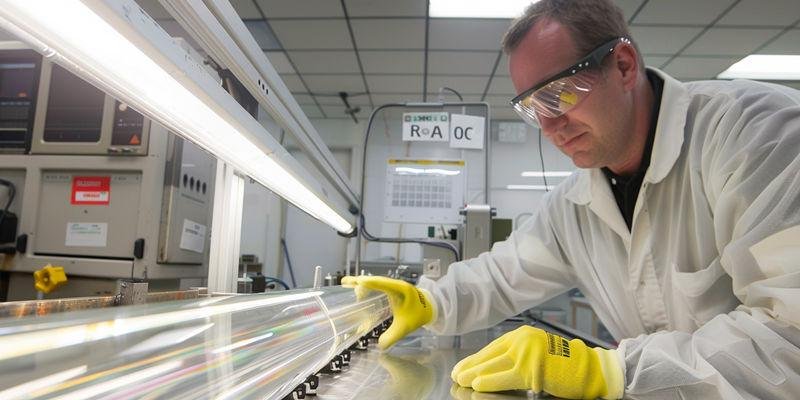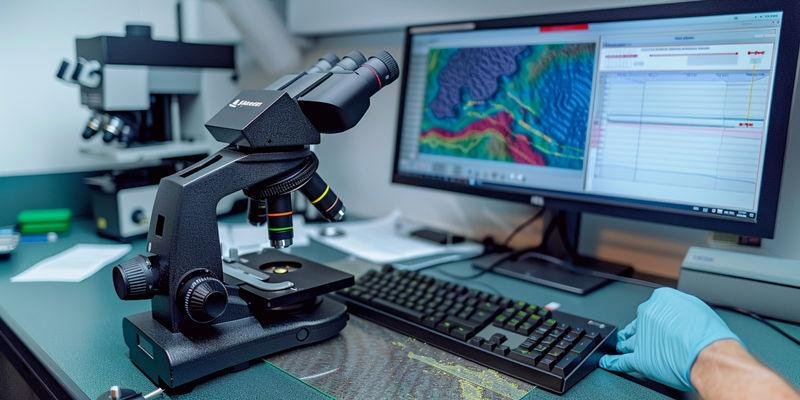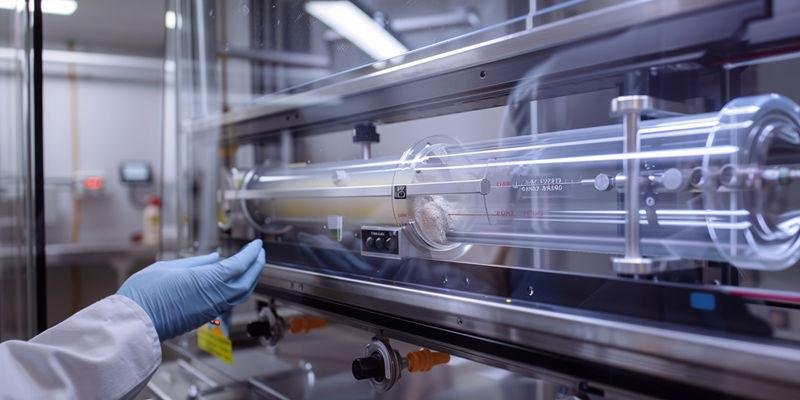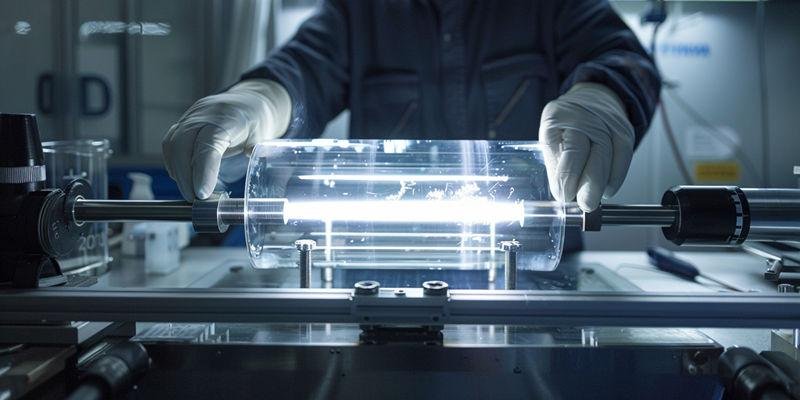
Surface finish plays a critical role in the optical performance of quartz tubes. Even small changes in surface roughness can cause significant differences in light transmission, scattering, and overall clarity. Engineers must carefully select the appropriate surface finish for each optical application. A smoother surface reduces unwanted scatter and maintains high transmission efficiency. When quartz tubes polished finishes meet strict surface requirements, optical systems deliver more reliable and accurate results. The right choice of surface finish ensures that optical components function as intended in demanding environments.
주요 내용
Surface finish quality is vital for achieving high optical clarity in quartz tubes. Smoother surfaces reduce light scattering and enhance transmission efficiency.
Engineers should select surface finishes based on specific application needs. Precision-polished tubes offer better performance in UV and high-clarity applications.
Understanding scratch-dig ratings helps ensure consistent optical quality. Lower ratings indicate fewer defects, leading to improved light transmission.
Utilizing advanced measurement techniques like interferometry ensures that surface finishes meet required standards for optical performance.
Balancing surface finish quality with cost and lead time is essential. Engineers must evaluate the total cost of ownership to make informed decisions.
What Surface Roughness Specifications Determine Optical Clarity in Quartz Tubes?

Surface roughness directly impacts the optical clarity of 쿼츠 튜브. Engineers must understand how different specifications affect transmittance, haze, and clarity. Selecting the right surface finish ensures high optical clarity and optimal performance in demanding optical applications.
Understanding MIL-PRF-13830B Scratch-Dig Specifications for Quartz Tubes
MIL-PRF-13830B sets the standard for evaluating surface quality in quartz tubes polished finishes. This specification uses scratch-dig ratings to define acceptable levels of scratches and digs, which are critical factors affecting optical clarity and transmittance. The rating system ensures that quartz tubes polished finishes meet the requirements for high optical clarity and low haze in precision optics.
그리고 scratch-dig specification assigns numerical values to the width of scratches and the diameter of digs. For example, a 60-40 rating means the maximum scratch width is 60 microns, and the largest dig diameter is 400 microns. Inspection occurs under controlled lighting, and the total length or diameter of defects must not exceed set limits, ensuring that quartz tubes polished finishes maintain high optical clarity and low haze. These standards help engineers select tubes with the right clarity for their application, reducing the risk of unwanted scatter and haze.
기능 | Specification Details |
|---|---|
Scratch Measurement | Width-based grades; e.g., 60-40 S-D means max width of allowed scratch is 60 μm. |
Scratch Inspection | Visual evaluation under controlled illumination; compared to reference patterns. |
Total Scratch Length | Sum of all scratches ≤ 1/4 of the clear aperture diameter. |
Dig Measurement | Measured by diameter; max allowable dig diameter is 400 μm (0.4 mm). |
Dig Inspection | Visual evaluation under controlled light. |
Total Dig Diameter | Sum of all digs ≤ twice the max size dig per 20 mm. |
Bubbles/Inclusions | Treated as digs. |
This table highlights how MIL-PRF-13830B links surface defects to clarity and transmittance, guiding engineers in ensuring optical clarity for critical applications.
How Surface Roughness Affects UV Transmission Below 250nm
Surface roughness at the nanometer scale plays a major role in determining optical clarity and transmittance in quartz tubes polished finishes. When the surface roughness exceeds 20 angstroms (Å) RMS, light scattering increases, causing a drop in clarity and a rise in haze. Quartz tubes polished finishes with roughness below 20Å RMS achieve high optical clarity and low haze, which is essential for UV applications below 250nm.
A smoother surface allows more light to pass through with minimal scatter, resulting in higher transmittance and better clarity. For example, reducing surface roughness from 50Å to 20Å RMS can improve transmittance by up to 12% at wavelengths below 300nm. This improvement means that quartz tubes polished finishes with low surface roughness deliver high optical clarity, low haze, and reliable optical properties for demanding UV systems.
핵심 포인트:
Surface roughness below 20Å RMS ensures high optical clarity and low haze.
Transmittance increases as surface roughness decreases.
Quartz tubes polished finishes with smoother surfaces perform better in UV applications.
These factors affecting optical clarity show why engineers must specify the right surface finish for UV and high optical clarity requirements.
Measuring Surface Finish with Interferometric and Profilometric Methods
Accurate measurement of surface finish is essential for ensuring high optical clarity and low haze in quartz tubes polished finishes. Interferometric methods use light interference patterns to measure surface shape and texture with high precision. This technique provides the best lateral accuracy and height resolution, making it ideal for verifying the clarity and transmittance of optical surfaces.
Profilometric methods, especially white light interferometry, allow for non-destructive and exact measurement of surface profiles. These methods help detect minute defects that could impact clarity, haze, and transmittance. Engineers rely on these measurements to confirm that quartz tubes polished finishes meet the required standards for high optical clarity and low haze.
Measurement Method | Accuracy | Impact on Clarity |
|---|---|---|
High lateral and height resolution | Ensures high optical clarity and low haze | |
Non-destructive, exact | Detects defects affecting clarity and transmittance |
By using these advanced measurement techniques, engineers can verify that quartz tubes polished finishes deliver the clarity, low haze, and transmittance needed for high-performance optical systems.
How Do Fire-Polished and Mechanically Polished Finishes Differ in Performance?

Engineers often compare fire-polished and mechanically polished quartz tubes to determine which finish best suits their optical applications. Each method produces a different smooth surface quality, affecting transmission and clarity. Understanding these differences helps engineers select the right tube for optimal performance.
Thermal Effects on Glass Structure During Fire Polishing
Fire polishing uses high temperatures to create a smooth surface on quartz tubes. The process involves heating the glass to around 1700°C, which melts the outer layer and allows surface tension to smooth out irregularities. This technique produces a smoother surface than untreated glass, but it may leave visible striae that affect optical clarity.
The rapid heating and cooling during fire polishing can cause changes in the glass structure. These changes sometimes lead to localized variations in refractive index, which may reduce transmission efficiency in optical systems. Engineers must consider these effects when choosing fire-polished tubes for applications that require a consistently smooth surface.
원인 | 효과 |
|---|---|
High temperature | Melts glass, creates smooth surface |
Rapid cooling | May introduce striae and refractive changes |
Surface tension | Reduces irregularities, improves clarity |
This table shows how fire polishing impacts the glass structure and the resulting smooth surface quality.
Multi-Stage Mechanical Polishing Process for Optical-Grade Surfaces
Mechanical polishing uses a series of abrasive steps to achieve a highly smooth surface on quartz tubes. Engineers start with coarse abrasives and gradually switch to finer ones, reducing surface roughness from hundreds of nanometers to below 20 angstroms. This multi-stage process improves optical transparency and ensures consistent performance.
During mechanical polishing, the material removal rate can reach 141 μm/h, and the surface can improve from 1.209 μm to 102 nm under optimized conditions. The developed CMSTP method increases polishing efficiency by 24% compared to older techniques. These improvements help engineers achieve the smooth surface needed for demanding optical applications.
핵심 포인트:
Mechanical polishing produces a highly smooth surface for optical use.
Multi-stage polishing reduces roughness and improves transparency.
Engineers rely on this process for consistent optical performance.
These points highlight why mechanical polishing is preferred for applications that demand the highest optical clarity.
Comparative Analysis of Surface Homogeneity in Different Finish Types
Surface homogeneity affects the optical performance of quartz tubes. Mechanically polished tubes offer a more uniform smooth surface, which leads to better transmission and less distortion. Fire-polished tubes, while smoother than untreated glass, may show striae and localized variations that impact clarity.
Engineers observe that mechanically polished tubes maintain refractive index uniformity within 2 × 10⁻⁶, while fire-polished tubes can vary by 8-15 × 10⁻⁶. This difference means that mechanically polished tubes deliver more reliable optical performance in systems where clarity and transmission matter most. Choosing the right finish ensures that the smooth surface meets the needs of each application.
요약:
Mechanically polished tubes provide superior surface homogeneity.
Fire-polished tubes may show visible striae and refractive index changes.
Engineers select the finish based on required optical performance.
This comparison helps engineers match the smooth surface quality to the demands of their optical systems.
Which Applications Require Precision-Polished Versus Standard-Finish Quartz Tubes?
Engineers select quartz furnace tube finishes based on the demands of each optical application. Surface finish determines how well a tube transmits light and resists environmental stress. Choosing the right surface ensures reliable performance and long service life in both laboratory and industrial settings.
Surface Finish Requirements for Different Wavelength Ranges (UV to IR)
Surface finish plays a key role in the transmission of light across different wavelength ranges. Engineers specify polished quartz furnace tube surfaces for applications that require high optical clarity, especially in the ultraviolet and infrared regions. Tubes with a precision-polished surface finish maintain greater than 90% transmission from 250nm to 2500nm, which is essential for spectroscopy and laser systems.
Surface finish options include UV-blocking coatings, corrosion-resistant layers, and custom texturing. UV-blocking coatings absorb nearly all UV radiation between 200–400nm, while polished finishes maximize optical clarity for sensitive measurements. Data shows that tubes with a polished surface finish deliver less than 1% transmission loss per meter in the UV range, compared to standard tubes that may lose up to 10%.
Surface Finish Type | 설명 |
|---|---|
UV-Blocking Coating | Absorbs UV light, blocks 99.9% of UV radiation (200–400nm) |
Corrosion-Resistant Coating | Increases durability in harsh environments |
광택 마감 | Maintains >90% transmission (250nm–2500nm), ideal for optical clarity |
Textured Finish | Reduces reflection, used for non-optical applications |
This table highlights how surface finish affects transmission and durability, guiding engineers to select the best quartz furnace tube for each wavelength range.
How Surface Topography Affects Fluid Dynamics in Microfluidic Quartz Tubes
Surface topography influences fluid flow and mixing in microfluidic quartz furnace tube systems. Engineers observe that rough surfaces increase friction and pressure loss, while smooth surfaces promote laminar flow and precise control. Microscopic irregularities on the surface enhance heat and mass transfer, which improves mixing efficiency in analytical devices.
Recent research shows that increased surface roughness leads to higher friction factors and more turbulent flow. Lower roughness yields smoother flow conditions, which is critical for applications like flow cytometry and chemical analysis. Data indicates that tubes with a polished surface finish reduce turbulence and improve measurement accuracy by up to 15% compared to standard tubes.
핵심 포인트:
Surface roughness affects flow behavior and pressure distribution.
Smooth surfaces improve laminar flow and measurement accuracy.
Engineers select surface finish based on fluid dynamics needs.
These factors help engineers choose the right quartz furnace tube surface for microfluidic applications, ensuring optimal optical and fluidic performance.
Thermal Stress Distribution in Polished Versus Unpolished Tube Surfaces
Thermal stress distribution depends on the surface finish of quartz furnace tube components. Engineers find that polished surfaces distribute thermal stress more evenly, reducing the risk of cracking during rapid temperature changes. Unpolished surfaces, especially at sharp corners, concentrate stress and increase the likelihood of failure.
Studies reveal that thermal stress at the 90° corners of square tubes can be up to 2.3 times higher than on curved surfaces. Engineers recommend limiting ramp rates and reinforcing corners to mitigate these risks. Polished surface finish helps maintain structural integrity and extends the service life of quartz furnace tube systems.
원인 | 효과 |
|---|---|
Polished Surface Finish | Even stress distribution, lower risk of cracks |
Unpolished Surface/Sharp Corners | Stress concentration, increased cracking risk |
Corner Reinforcement | Reduces stress, improves durability |
This table shows how surface finish and design choices affect thermal stress, helping engineers optimize quartz furnace tube performance in demanding environments.
What Quality Standards Validate Precision Polishing in Quartz Tube Manufacturing?
Precision polishing in quartz tube manufacturing relies on strict standards to ensure consistent surface finish and optical performance. Engineers use international guidelines to validate that each surface meets the required quality for demanding applications. These standards help manufacturers deliver reliable optical components for scientific and industrial use.
Interpreting ISO 10110 Surface Imperfection Notation for Quartz Tubes
ISO 10110-7 provides a clear system for describing surface imperfections in optical quartz tubes. This standard uses codes to specify the number and area of allowed imperfections, such as scratches and coating blemishes, on each surface. Engineers apply these codes during both visual and measurement inspections to ensure each surface finish meets the required optical quality.
The table below summarizes how ISO 10110-7 applies to quartz tubes, highlighting the cause-effect relationships between inspection stages and surface quality:
측면 | 설명 |
|---|---|
표준 | ISO 10110-7 |
초점 | Measurement of surface imperfections in optical elements |
유형 | Localized imperfections, scratches, coating blemishes |
검사 | Visual (first stage), Measurement (second stage) |
Notation | Codes for surface imperfections and coating blemishes |
애플리케이션 | Transmitting and reflecting coated/uncoated surfaces of optical elements |
This approach ensures that each surface finish supports high optical performance and meets international quality expectations.
Test Methods for Subsurface Damage Detection After Polishing
Detecting subsurface damage after polishing is essential for maintaining the optical quality of quartz tubes. Engineers use both destructive and non-destructive test methods to evaluate the surface and underlying layers. Non-destructive techniques, such as optical coherence tomography and scanning acoustic microscopy, allow for thorough inspection without harming the tube.
Destructive methods, including cross-sectional microscopy and chemical etching, provide detailed information about the depth and type of subsurface damage. These tests help manufacturers confirm that the surface finish does not hide flaws that could affect optical performance. Data shows that combining both types of tests increases detection accuracy by up to 30%.
핵심 포인트:
Non-destructive tests preserve tube integrity while detecting hidden flaws.
Destructive tests reveal detailed subsurface information.
Combining methods improves detection rates and ensures optical quality.
These methods give engineers confidence that each surface finish will perform reliably in optical systems.
Cleanroom Requirements for Maintaining Optical-Grade Surface Quality
Maintaining optical-grade surface quality requires strict cleanroom protocols during manufacturing. Engineers work in ISO Class 7 (Class 10,000) cleanrooms to prevent contamination of the surface finish. The cleaning process uses ultrasonic baths and approved container materials, such as plastic or stainless steel, to remove microscopic particles from each surface.
Cleanroom standards ensure that the surface remains free from dust and other contaminants that could reduce optical performance. Data from manufacturing environments shows that following these protocols reduces surface defects by over 60%. The table below highlights the key cleanroom requirements and their effects on surface finish quality:
사양 | 세부 정보 |
|---|---|
Cleanroom Class | ISO Class 7 (Class 10,000) |
Cleaning Process | Ultrasonic bath removes microscopic contaminants |
Container Materials | Plastic or stainless steel prevents contamination |
애플리케이션 | Ensures high-quality output for optical components |
These requirements help manufacturers deliver quartz tubes with a surface finish that meets the highest optical quality standards.
How Can Engineers Optimize Quartz Tube Selection Based on Surface Finish Requirements?
Engineers must evaluate several factors when choosing quartz tubes for optical systems. The selection process involves balancing surface finish specifications, cost, and application needs. Careful optimization ensures that each tube delivers the required quality and performance for its intended use.
Creating Surface Finish Decision Matrices for Multi-Application Systems
Engineers often use decision matrices to compare surface finish options for multi-application optical systems. These matrices help organize factors such as transmission, surface roughness, and chemical stability, making it easier to select the best tube for each scenario. By assigning scores to each factor, engineers can visualize trade-offs and prioritize requirements.
Data from laboratory studies shows that tubes with a surface roughness below 20Å RMS achieve transmission rates above 94% in UV applications, while those with higher roughness may drop below 85%. Decision matrices allow engineers to weigh these performance metrics against cost and lead time, ensuring that the selected tube meets both optical and operational needs. The following table summarizes key factors and their impact on selection:
요인 | 설명 |
|---|---|
High UV and visible transmission | Accurate optical measurements and reduced signal loss |
Low autofluorescence | Prevents interference in sensitive optical analyses |
화학적 안정성 | Maintains tube integrity in harsh environments |
Surface finish specification | Ensures optimal performance for each optical instrument |
Purity specification | Guarantees reliable optical measurement quality |
Decision matrices provide a structured approach, helping engineers make informed choices for complex optical systems.
Balancing Surface Quality Specifications with Lead Time and Cost Constraints
Engineers must balance surface quality specifications with practical constraints like lead time and cost. High-quality optical tubes with precision-polished surfaces often require longer manufacturing times and higher investment. Selecting the right balance ensures that projects stay on schedule and within budget without sacrificing essential optical performance.
Recent industry surveys indicate that precision-polished tubes can cost up to 120% more than fire-polished alternatives, but they deliver up to 12% higher transmission efficiency in demanding optical applications. Engineers should consider the total cost of ownership, including maintenance and calibration frequency, when evaluating surface finish options. By comparing performance data and cost estimates, they can identify the most cost-effective solution for each project.
핵심 포인트:
Precision-polished surfaces improve optical transmission but increase cost.
Lead time varies based on surface finish requirements and manufacturing complexity.
Engineers must weigh performance benefits against project constraints.
This approach helps engineers optimize tube selection, ensuring that both surface quality and project goals align for successful optical system deployment.
Surface finish quality directly shapes the optical performance of quartz tubes. Engineers see that smoother surfaces reduce flaws such as pits and cracks, which can otherwise increase chemical activity and lower reliability. Medium-pressure plasma processes and wet chemical etching help improve surface quality by reducing roughness and subsurface defects.
Surface finish quality is crucial for high-quality optical components.
Flaws can increase corrosion and impact performance.
Improved methods reduce roughness and defects.
Matching surface finish specifications to each application ensures optimal results. Documented standards and validation protocols support reliable tube selection for critical systems. These standards help maintain chemical integrity, minimize measurement errors, and align with updated safety protocols.
Documented standards ensure compatibility and reliability.
Adhering to protocols reduces risks and supports repeatable results.
Updated standards align with safety and performance needs.
Engineers who follow these practices achieve consistent results in demanding optical environments.
자주 묻는 질문
Why does surface finish quality matter for UV transmission in quartz tubes?
Surface finish quality controls how much light passes through quartz tubes. Smoother surfaces reduce light scattering. This leads to higher UV transmission and better measurement accuracy.
참고: Engineers see up to 12% more UV transmission with precision-polished tubes.
Why should engineers specify scratch-dig ratings for optical quartz tubes?
Scratch-dig ratings set clear limits for surface defects. These ratings help engineers ensure consistent optical clarity. Lower scratch-dig values mean fewer imperfections and less light scatter.
Scratch-Dig Rating | Optical Impact |
|---|---|
20/10 | High clarity, low scatter |
80/50 | Lower clarity, more scatter |
Why do mechanically polished tubes outperform fire-polished tubes in optical systems?
Mechanically polished tubes have smoother, more uniform surfaces. This uniformity improves light transmission and reduces distortion. Fire-polished tubes may show striae, which can lower optical performance.
핵심 포인트:
Uniform surfaces boost clarity
Less distortion in optical paths
Better for precision systems
Why do cleanroom conditions matter during quartz tube polishing?
Cleanroom conditions prevent dust and particles from contaminating the surface. Contamination can cause defects that reduce optical performance. Clean environments help maintain the high quality needed for optical-grade tubes.
Why should engineers balance cost and surface finish requirements?
Precision-polished tubes cost more but deliver better optical results. Engineers must weigh project budgets against performance needs. Choosing the right finish ensures reliable results without unnecessary expense.




